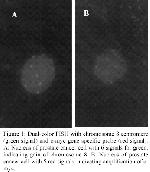Recent studies have indicated that several chromosomes (7, 8, 10 and Y) play important roles in tumorigenesis and tumor progression of prostate cancer
1,14. Numerical chromosomal anomalies were found in 67%, 68%, and 96% of foci of PIN, carcinoma, and metastases, respectively. Chromosome 8 alterations, including loss of 8p21-22 and gain of 8q24, are commonly observed in prostate carcinoma. Sato et al. reported that alterations of c-myc were associated with both systemic progression and patient deaths
15. We found extra copies of c-myc in chromosome 8 centromere in 16% of PIN (case14), 22% of cancer (case 6 and 8).
A variety of factors may contribute to gain of c-myc. Simple gain of the whole chromosome 8 can account for many cases with extra copies of c-myc. Chromatid separation in proliferative cells will result in an apparent increase in the number of region-specific probe signals. Some studies have also reported loss of 8p concurrent with gain of the long arm of chromosome 8 (8q) sequences in advanced prostatic cancer. This combination of events occurring on the same chromosome–loss of 8p seguences and gain of 8q sequences-suggests formation of i(8q) chromosomes in advanced prostate tumors 16. Alers et al. (1997) reported that overrepresentation of 8q sequences, most likely by isochromosome 8q formation, is involved in metastatic spread to the bone 17.
Brown et al reported that anomalies of chromosomes 8 and/or 7, present in 14 of the 16 cases (88%) aneusomic by FISH and high-grade tumors, were more likely to be aneuploid on FISH (18). The present study showed similar findings with an 88.8% gain of chromosome 8 in adenocarcinomas.
Oncogene amplification is one mechanism that leads to stepwise progression in solid tumors. Moreover, oncogene amplification may be a useful indicator of progressional prognosis in various human cancers 19. c-myc amplification is not common in prostate cancer specimens, although FISH has been demonstrated to be a sensitive technique for detecting changes in gene copy number. Miyoshi et al. reported that c-myc gene amplification was detected in 8%, 19%, and 46% of PIN, carcinoma and metastases of prostate 20. Bubendorf et al. reported no cases of high level myc amplification in primary tumors 21. Alers et al. previously found c-myc amplification in 8% of primary prostate tumors and c-myc gene amplification which correlates with high levels of myc protein expression 22. Mark et al. reported that an increased copy number in c-myc oncogene copy number was not a prominent finding in their cohort of prostate cancer patients 13. In our study, c-myc gene amplification was found in 11.1% of prostate cancer cases. Interestingly, c-myc gene amplification has been shown to occur in a case with primary prostate cancers without metastases and untreated prostate cancers in the present study. Our results support the findings of others that c-myc gene amplification or copy number increase is not common in prostate cancer specimens.
Jenkins et al. found extra copies of c-myc in 50% of PIN foci, 44% of cancer, and 92% of lymph node metastases and these were usually observed simultaneously with gain of chromosome 8 centromere 4. Our study demonstrated that extra copies of c-myc were found in 100% of adenocarcinoma and 33.3% PIN.
Bastacky et al. have been show 36% in group B ( high-grade PIN, HGPIN/no PC) and 69% in group A (HGPIN/PC) for chromosome 8/c-myc. Using a cutoff of 4, between Group A and Group B were found statistically different 23. The present study found statistically significant difference between PIN and carcinomas for signals obtained from c-myc and chromosome 8 in most cells (p<0.05). This finding is important because it helps to differentiate between adenocarcinoma and PIN.
This report suggests that amplification and overexpression of c-myc alone with another gene(s) mapped to 8q, may play a key role in the progression and evaluation of prostatic carcinoma. Overall frequencies of extra c-myc copy anomalies and numeric chromosomal anomalies in PIN and carcinoma were similar, suggesting that they share a similar underlying pathogenesis. Thus, these findings suggest that PIN is a precursor of carcinoma. We conclude that an increase in c-myc oncogene copy number was not a prominent finding in our cohort of prostate cancer patients. We believe that the basic mechanism in overexpression of c-myc gene may not be amplification. Our results indicate that the basic mechanism of c-myc gene overexpression may be gain of simple chromosome 8 or gain of ‘’8q’’. Our results concerning c-myc amplification and gain of chromosome 8 in prostate cancer in Turkish patients are consistent with the results observed in prostate cancer in Western countries and suggest that these genetic and chromosomal changes may be associated with the development and progression of prostate cancers.





